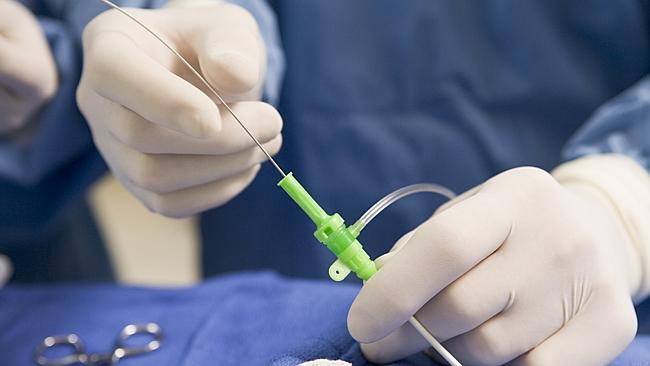
A surgeon inserting a tube into patient during transplant surgery. Source: Getty Images
- Sydney surgeon’s dead heart transplant a huge medical breakthrough
- Previously, transplants relied on donor hearts from brain dead patients
- Ability to revive hearts has major implications for donor shortages
- Two successful transplants performed in last two months
IN a world first, surgeons at St Vincent’s Hospital have made a dead heart beat again and successfully used it in a transplant.
Described as the biggest heart transplant breakthrough in a decade, the successful surgery has profound implications for reducing the shortage of donor organs, the director of St Vincent’s Hospital Heart Lung Transplant Unit, Professor Peter MacDonald, said today.

The ‘heart in a box’ machine at work. Source: Supplied
Previously transplant units relied solely on donor hearts from brain dead patients whose hearts were still beating.
But the clinic has recently transplanted two hearts which were donated after circulatory death (DCD) — where the heart is no longer beating — in both cases the patients are recovering well.
The first person to have the procedure done was Michelle Gribilar. The 57-year-old from Campsie was suffering from congenital heart failure and had surgery about two months ago.
She is recovering well with a spokesman for the hospital saying she told surgeons “she feels like she is 40” since the transplant.
In a world first surgeons at St Vincent’s have transplanted a heart that had stopped beating .#9NewsAt6 pic.twitter.com/sIU1oRUI34
— Mark Burrows (@MarkWBurrows) October 23, 2014
The second patient, Jan Damen, 40, from North Narrabeen also suffered from congenital heart failure and had surgery about a fortnight ago. He is still recovering at the hospital.
The transplants of DCD hearts comes as the result of combined research between the Victor Chang Cardiac Research Institute and St Vincent’s Hospital.
CUTTING-EDGE CANCER TREATMENT AND RESEARCH CENTRE OPENS
SURVIVOR LEADS CAMPAIGN TO SUPPORT PINK RIBBON DAY
The two clinics created a special preservation solution which works in conjunction with a “heart in a box” machine, known as the ex vivo organ care system (OCS).

Kumud Dhital, the transplant surgeon with the monitor with the heart-in-a-box. Coming back from the retrieval in a jet. Source: Supplied
The OCS allows the donor heart to be connected to a sterile circuit which restores the heart beat and keeps it warm, limiting the adverse affects associated with previous methods which saw hearts kept on ice.
Cold ischaemia, where the heart is dormant without oxygen or nutrients occurs under traditional methods where hearts are kept in an Esky on ice.
But using the preservative solution and the heart in a box, the heart is able to be reanimated, preserved and assessed until it is ready to go into a recipient.
The move to recover hearts which were previously considered unsuitable for transplantation means that thousands more hearts could become available to end-stage heart failure sufferers as the technology becomes more readily available, said professor MacDonald.
“In all our years, our biggest hindrance has been the limited availability of organ donors,” Prof MacDonald said.
Researchers are still determining how long after DCD a heart can be resuscitated, but have revived hearts more than 30 minutes after death.

Things have changed dramatically since Australia’s first heart transplant recipient Fiona Coote underwent surgery at St Vincent’s Hospital in 1984. Source: News Corp Australia
